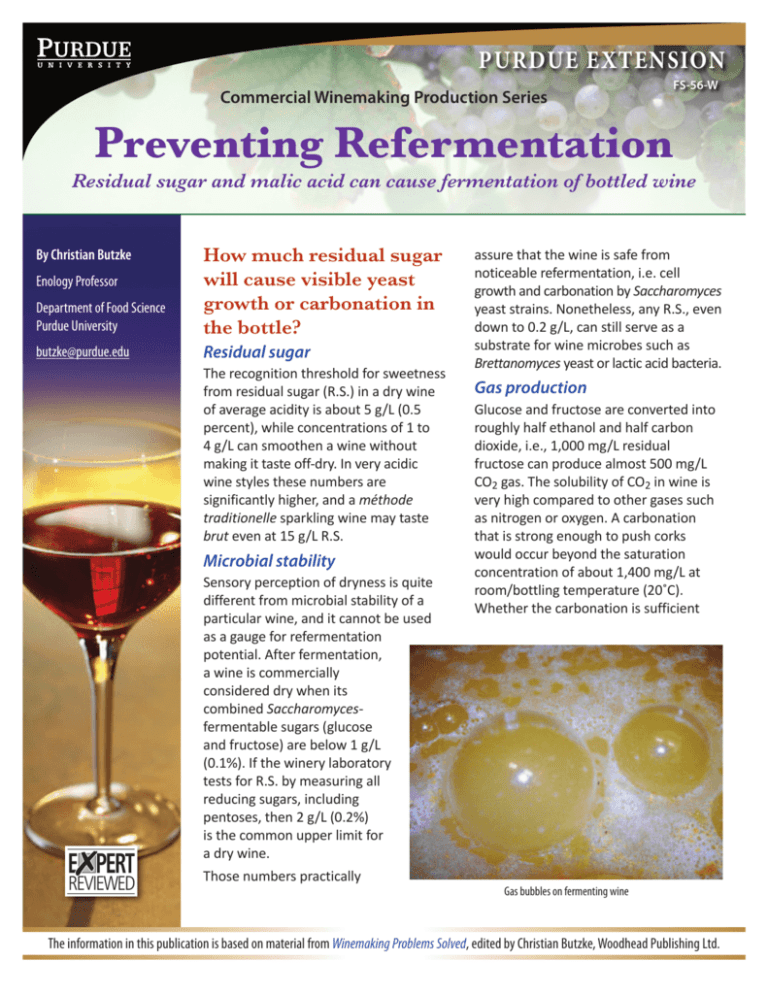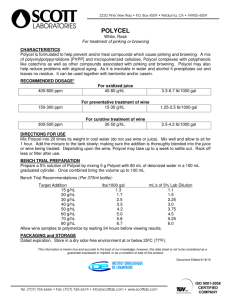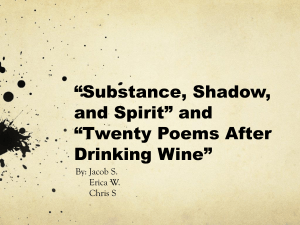Preventing Refermentation - Purdue Extension
advertisement

Purdue Extension Commercial Winemaking Production Series FS-56-W Preventing Refermentation Residual sugar and malic acid can cause fermentation of bottled wine Department of Food Science Purdue University How much residual sugar will cause visible yeast growth or carbonation in the bottle? butzke@purdue.edu Residual sugar By Christian Butzke Enology Professor The recognition threshold for sweetness from residual sugar (R.S.) in a dry wine of average acidity is about 5 g/L (0.5 percent), while concentrations of 1 to 4 g/L can smoothen a wine without making it taste off-dry. In very acidic wine styles these numbers are significantly higher, and a méthode traditionelle sparkling wine may taste brut even at 15 g/L R.S. Microbial stability Sensory perception of dryness is quite different from microbial stability of a particular wine, and it cannot be used as a gauge for refermentation potential. After fermentation, a wine is commercially considered dry when its combined Saccharomycesfermentable sugars (glucose and fructose) are below 1 g/L (0.1%). If the winery laboratory tests for R.S. by measuring all reducing sugars, including pentoses, then 2 g/L (0.2%) is the common upper limit for a dry wine. Those numbers practically assure that the wine is safe from noticeable refermentation, i.e. cell growth and carbonation by Saccharomyces yeast strains. Nonetheless, any R.S., even down to 0.2 g/L, can still serve as a substrate for wine microbes such as Brettanomyces yeast or lactic acid bacteria. Gas production Glucose and fructose are converted into roughly half ethanol and half carbon dioxide, i.e., 1,000 mg/L residual fructose can produce almost 500 mg/L CO2 gas. The solubility of CO2 in wine is very high compared to other gases such as nitrogen or oxygen. A carbonation that is strong enough to push corks would occur beyond the saturation concentration of about 1,400 mg/L at room/bottling temperature (20˚C). Whether the carbonation is sufficient Gas bubbles on fermenting wine The information in this publication is based on material from Winemaking Problems Solved, edited by Christian Butzke, Woodhead Publishing Ltd. to push out a cork is strongly influenced by bottle headspace volume and closure type. A perceivable spritz may be tasted at 800 mg/L CO2, which would require 1.6 g/L refermentable fructose or glucose. Haze formation Saccharomyces may grow if the recommended doses of sorbate and sulfur dioxide are not met, or the sterile filtration prior to bottling was compromised. It has been reported that even 100 mg/L residual pentoses can lead to a visible Brettanomyces yeast haze if proper SO2 management and filter integrity tests are not implemented. A visible haze due to the growth of Saccharomyces must certainly be expected above 1,000 mg/L R.S. How much residual malic acid will cause visible malolactic bacteria growth or carbonation in the bottle? Malic acid Grapes at harvest contain between 0.6 and 6 g/L of malic acid, depending on the growing climate. Malic acid and tartaric acid are the main acids in grapes and wine, but wine bacteria cannot metabolize tartaric acid during the malolactic fermentation (MLF). Malolactic bacteria can turn malic acid into lactic acid and carbonic acid, which leaves the fermentor as carbon dioxide, thereby reducing the acidity of the wine. Traditionally, the conversion of malic to lactic acid is monitored in the winery lab via paper chromatography. This method is semi-quantitative, and the absence of a malic acid spot on the chromatogram indicates a concentration of less than 30 mg/L, a barely visible one about 200 mg/L. It is commercially assumed that if a wine completes MLF, the residual malic acid is less than 300 mg/L or 0.3 g/L. Gas production Malic acid is stoichiometrically converted into twothirds lactic acid and one-third CO2, i.e., 300 mg/L residual acid could produce 100 mg/L gas. The solubility of CO2 in wine is relatively high, and corkpushing carbonation would occur only beyond the saturation concentration of about 1,400 mg/L at room/bottling temperature (20˚C). A perceivable spritz may be tasted at 800 mg/L CO2, which would require the malolactic fermentation of 2.4 g/L malic acid. Haze formation MLF bacteria will grow based on residual nutrients in the wine if malic acid is present, and a visible haze in a white wine due to the growth of Oenococcus oeni can be expected above 300 mg/L (0.3 g/L). References www.vinquiry.com/pdf/05FallNwsltr.pdf — The Vinquiry Report, September 2005 Wine Analysis and Production. Zoecklein, B., et al., p. 91-92, Springer, New York, 1995. Winemaking Basics. C. Ough., p. 85, Haworth Press, New York, 1992. Wine Analysis and Production. Zoecklein, B., et al., p. 296, Springer, New York, 1995. Reviewed by: Richard Linton Professor of Food Science and Director of the Center for Food Safety Engineering Department of Food Science, Purdue University Bruce Bordelon Viticulture Professor Department of Horticulture & Landscape Architecture, Purdue University Purdue Agriculture New 03/10 It is the policy of the Purdue University Cooperative Extension Service that all persons have equal opportunity and access to its educational programs, services, activities, and facilities without regard to race, religion, color, sex, age, national origin or ancestry, marital status, parental status, sexual orientation, disability or status as a veteran. Purdue University is an Affirmative Action institution. This material may be available in alternative formats. Order or download materials from Purdue Extension • The Education Store www.extension.purdue.edu/store





